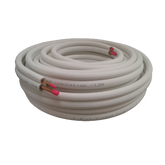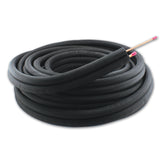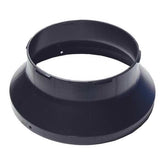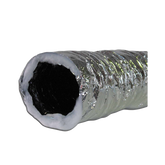Sealing Process
An overview of the duct sealing process and operation

Preparation:
We inspect the system, looking for larger leaks and any other factors that need to be addressed before we start our operation. We isolate the run/section of ductwork to be sealed. We block off all sensing equipment, isolate AHUs/VAVs and block grilles etc with closed cell foam plugs, and cap ductwork ends/branches/VAV boxes. Fire dampers must be open. Ducts to be sealed must not be very dirty (3-4mm of debris is fine) and must also be dry and free of grease. As a general rule, vertical kitchen exhausts are fine (if grease-free), but horizontal branches to kitchen hoods are looked at on a case by case basis.
Set-up:
We need one access/injection point to the ductwork section, and usually cut an access hole (ideally 300mm), attach a collar and clamp a length (2.8m) of clear plastic tubing to connect the Aeroseal unit. This unit includes a fanbox to maintain duct pressure, manometers to measure the pressure differential across the fanbox, and thermostats and heaters to heat the sealant. Relative humidity is also monitored. An air compressor with in-line modifications connects to the Aeroseal unit, supplying additional air pressure to aerosolise the sealant. The length of clear plastic tubing between the unit and the duct injection point acts as a mixing zone for the "fog" of sealant which then enters the ductwork. We are often able to complete a sealing event using simply the Aeroseal unit connected to the duct injection point via one straight line of clear plastic tubing, but we also have a booster unit for additional pressure, added in via a "Y kit" (a "Y" formation with an extra branch of clear plastic tubing). We can also reverse the Y kit and use the two branches of the Y as two separate access points to ductwork if need be (for more complex duct constructions).
The information required for the operation of the Aeroseal duct sealing process is:
- duct material/construction
- operating pressure (Pa)
- fan capacity (m3/h)
- A/C capacity (kW)
- main equipment model.
Pre-seal air leakage test:
Using our equipment at the injection point, we pressurise the duct section and run our pre-seal leakage test. This test gives the air leakage in both L/s and “centimeter squared equivalent hole size”- the total leakage area.
This airflow/leakage information is used within the software that drives the sealing process. So, while we are not independent air leakage testers, our data is very accurate. We need it to be.
If we are unable to maintain the necessary duct pressure to achieve a pre-seal leakage result, this indicates that the leakage is too high to be effectively sealed, so we discuss with our client and identify any missed grilles or larger leak sites that require manual sealing or reduce the size of the duct section and continue.
The test takes a few minutes and we then start the sealing process.
How the sealing process works:
Via our injection point, the Aeroseal equipment maintains duct pressure (up to 570Pa) and sprays in aerosolised sealant to create a “fog” which fills the duct. This fog of sealant keeps moving within the duct until it accelerates, bottle-necks and deposits at leak sites. The sealant bonds to the edges of the leak, then to itself until each leak is completely sealed. Duct pressure and remaining leakage are continually monitored by two or three onsite technicians to avoid over-saturating the duct, and where leak sites are in sensitive areas (like computer rooms), we cover any equipment and use HEPA scrubber fans to pick up any escaping sealant (overspray). It often takes less than an hour to seal a section of ducting. As long as we can pressurise the duct to a minimum of 15Pa, we can generally seal it. The fixed leaks are plugged with a sealant that looks a little like silicone and stays strong and flexible, which means duct movement doesn’t reopen the leak sites. Ducts are usually sealed in runs of about 50 metres, depending on the duct construction, configuration, diameters and leakages involved. The booster unit is used on larger/leakier sections, and while sealing 80% + of the leakage is usually considered a success, results of around 90% leakage sealed are most common, and we can also manipulate the process to achieve very high sealing rates (95% + leakage sealed).
Post-seal results:
Once ducts are airtight, we halt the sealing process and run a post- seal leakage test. We then pack down our prep work and return the ducts to service. We supply both the pre and post seal leakage test results to our clients. We guarantee the durability of the Aeroseal sealant for 10 years, and testing in the US (where Aeroseal sealant and equipment is manufactured) has shown no detectable deterioration on sealed leaks after 40 years worth of accelerated conditions.
Aeroseal:
- Is safe, stable and has been used to seal ducts in residential, commercial and healthcare facilities for over 20 years. Some hospitals had their own professionals assess the sealant for safety before they gave the OK for sealing to go ahead.
- Meets SMACNA Seal Class A.
- Is mould resistant (listed UL181 mould growth).
- Is non-flammable and fire resilient (listed UL723 smoke & flame spread).
- Is non-toxic and safe for food preparation areas (Aeroseal sealant has a Non-Food Compound Category R2 product listing from NSF [the National Sanitary Foundation in the US]. The listing certifies the sealant is in full compliance with the NSF’s program guidelines for Proprietary Substances & Nonfood compounds).
- Is low in VOCs (A+ French VOC rating).
- Remains effective under a huge range of conditions. It is used in Europe, the US and Australia, and now here in NZ. Sealed leaks can withstand up to 2,000Pa, and remain tough and pliable – so duct movement won’t compromise the seals.
Aeroseal technology has been used in the US for over 20 years [read US case studies] and is successful in Europe [read European case studies] and Australia.
- For laboratory, electronic and medical facilities, internal duct sealing means airborne hazards can be better isolated and controlled, that contaminated air is effectively removed, and clean, safe air is supplied.
- Our duct sealing team can help service providers and facility managers get ready for NABERSNZ, show energy management initiative, and come out ahead on performance evaluations.
- Our duct sealing team can help service providers and facility managers get ready for NABERSNZ, show energy management initiative, and come out ahead on performance evaluations.
- When you need to get across the line at commissioning, we can help get you there before penalties are incurred.
- You can be confident you’ll pass an IANZ airtightness test based on our results.
- And because the technology seals ducts from the inside, legacy issues like limited access are not a problem for Aeroseal.
Other ducting repair and remediation methods to reach airtightness targets can involve :
- Scaffolding (We recommend Affordable Scaffolding)
- Abseiling
- Working at heights or confined spaces
- Accessing ductwork behind walls and ceilings, and inadequate access panels and hatches for manual repair
- Smoke testing to locate air leaks
- Pressure tests to confirm air tightness is acceptable
- Business interruption and hours of labour while workers find, access and manually repair leaks with mastic and tape
With Aeroseal, we just need one access point to fix leaky ducts.
Find Us
- Address: 13 Fairfax Ave, Penrose, Auckland, NZ
- Phone: 09 571 3229
- Email: info@aeroseal.nz
- Choosing a selection results in a full page refresh.







